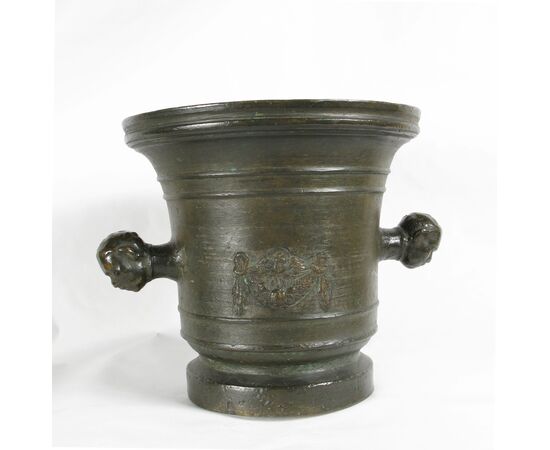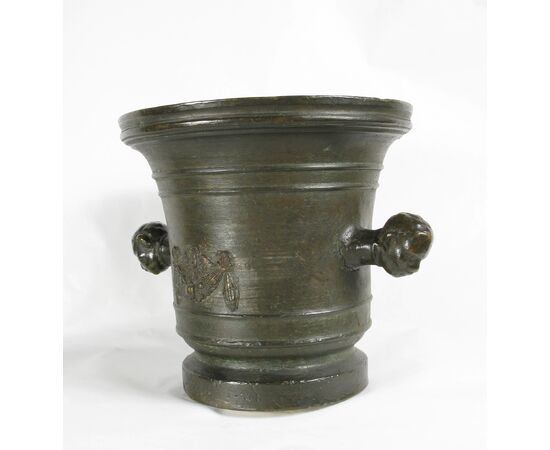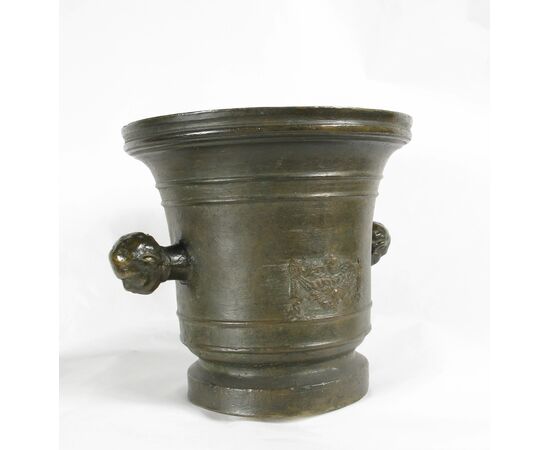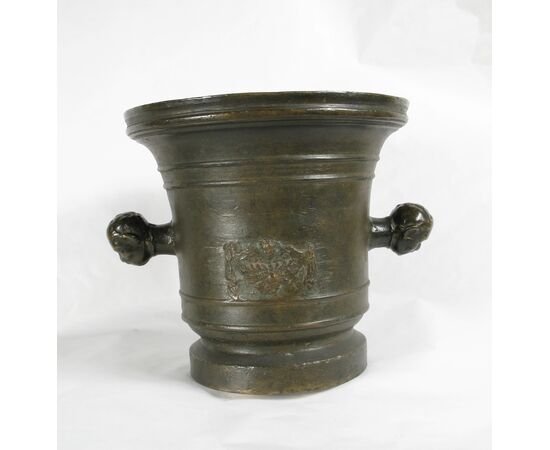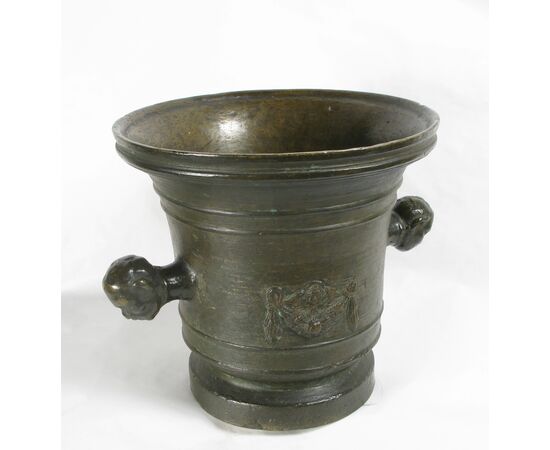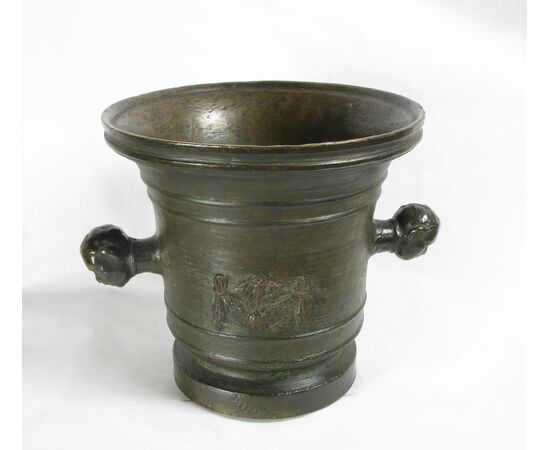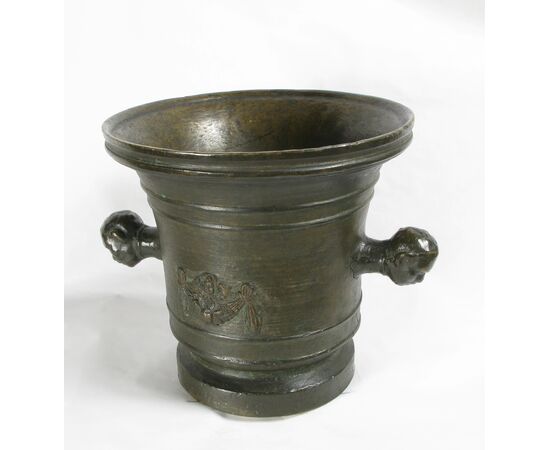Mortaio in bronzo, Veneto, XVI° secolo
Mortaio in bronzo fuso a cera persa con corpo delineato da cornici parallele e susseguenti che ne delimitano la circonferenza.
Sulle due facce, in posizione centrale, ghirlanda di fiori e frutti sormontata dal classico angelo del 1500 con le ali spiegate.
Due manici a carattere antropomorfo ne facilitano la presa e la movimentazione.
Veneto, XVI° secolo.
Dimensioni:
Altezza cm 28 x diametro inferiore cm 19 x diametro superiore cm 30
Questa particolare tipologia di mortai di bronzo, realizzati con la tecnica della fusione a cera persa, erano spesso destinati a un uso farmaceutico.
All’interno di essi infatti, varie materie prime venivano, con l’aiuto di bronzei pestelli, sminuzzate e triturate fino ad essere ridotte in polvere e poter quindi essere usate, sole o miscelate con altre, per scopi farmacologici.
In questo particolare caso, il manufatto d’uso era realizzato mediante complesse tecniche e ricercatamente foggiato ed ornato, dando luogo a delle opere d’arte particolarmente funzionali ed esteticamente molto ricercate ed accattivanti.
Bibliografia di riferimento
Giorgio Lise, “Antichi Mortai di farmacia”, 1975 Silvana editoriale d’arte, Milano
Ulrich Middeldorf, “Fifty Mortars 15th -18th Century”, 1981 Firenze
Nel caso l’opera venisse acquistata da clienti non italiani la stessa necessiterà dell’attestato di libera circolazione.
Lo stesso è ottenibile in 10/20 giorni lavorativi.
La galleria si occuperà degli aspetti burocratici ed economici della cosa.
Tutti i costi dell’operazione sono quindi inclusi nel prezzo.
L'opera, come ogni altro nostro oggetto, sarà venduta corredata da attestati di autenticità e lecita provenienza.
Ci occupiamo e organizziamo personalmente l'imballaggio e la spedizione delle opere d'arte con assicurazione in tutto il mondo
English
Bronze mortar, Veneto, 16th century
Lost wax cast bronze mortar with body outlined by parallel and successive frames that delimit its circumference.
On both faces, in a central position, a garland of flowers and fruit surmounted by the classic 1500 angel with outstretched wings.
Two anthropomorphic handles make it easier to grip and move.
Veneto, 16th century.
Dimensions:
Height 28cm x bottom diameter 19cm x top diameter 30cm
This particular type of bronze mortar, made with the lost wax casting technique, was often intended for pharmaceutical use.
In fact, inside them, various raw materials were, with the help of bronze pestles, chopped and ground until they were reduced to powder and could therefore be used, alone or mixed with others, for pharmacological purposes.
In this particular case, the artifact was made using complex techniques and carefully shaped and decorated, giving rise to particularly functional and aesthetically highly sought-after and captivating works of art.
Reference bibliography
Giorgio Lise, "Ancient pharmacy mortars", 1975 Silvana art editorial, Milan
Ulrich Middeldorf, “Fifty Mortars 15th -18th Century”, 1981 Florence
If the work is purchased by non-Italian customers, it will require the certificate of free circulation.
The same can be obtained in 10/20 working days.
The gallery will take care of the bureaucratic and economic aspects of the thing.
All costs of the operation are therefore included in the price.
The work, like all our other objects, will be sold accompanied by certificates of authenticity and lawful origin.
We personally take care of and organize the packing and shipping of the artworks with insurance all over the world
Français
Mortier en bronze, Vénétie, XVIe siècle
Mortier en bronze coulé à la cire perdue dont le corps est délimité par des cadres parallèles et successifs qui délimitent sa circonférence.
Sur les deux faces, en position centrale, une guirlande de fleurs et de fruits surmontée du classique ange 1500 aux ailes déployées.
Deux poignées anthropomorphes facilitent la préhension et le déplacement.
Vénétie, XVIe siècle.
Dimensions:
Hauteur 28cm x diamètre bas 19cm x diamètre haut 30cm
Ce type particulier de mortier en bronze, fabriqué selon la technique de la fonte à la cire perdue, était souvent destiné à un usage pharmaceutique.
En effet, à l'intérieur de celles-ci, diverses matières premières étaient, à l'aide de pilons en bronze, hachées et broyées jusqu'à ce qu'elles soient réduites en poudre et pouvaient donc être utilisées, seules ou mélangées à d'autres, à des fins pharmacologiques.
Dans ce cas particulier, l'artefact a été fabriqué à l'aide de techniques complexes et soigneusement façonné et décoré, donnant lieu à des œuvres d'art particulièrement fonctionnelles et esthétiquement très recherchées et captivantes.
Bibliographie de référence
Giorgio Lise, "Anciens mortiers de pharmacie", 1975 Éditorial d'art Silvana, Milan
Ulrich Middeldorf, « Cinquante mortiers XVe-XVIIIe siècle », 1981 Florence
Si l'œuvre est achetée par des clients non italiens, elle nécessitera le certificat de libre circulation.
La même chose peut être obtenue en 10/20 jours ouvrables.
La galerie s'occupera des aspects bureaucratiques et économiques de la chose.
Tous les frais de l'opération sont donc inclus dans le prix.
L'œuvre, comme tous nos autres objets, sera vendue accompagnée de certificats d'authenticité et d'origine licite.
Nous nous occupons et organisons personnellement l'emballage et l'expédition des œuvres avec assurance dans le monde entier

